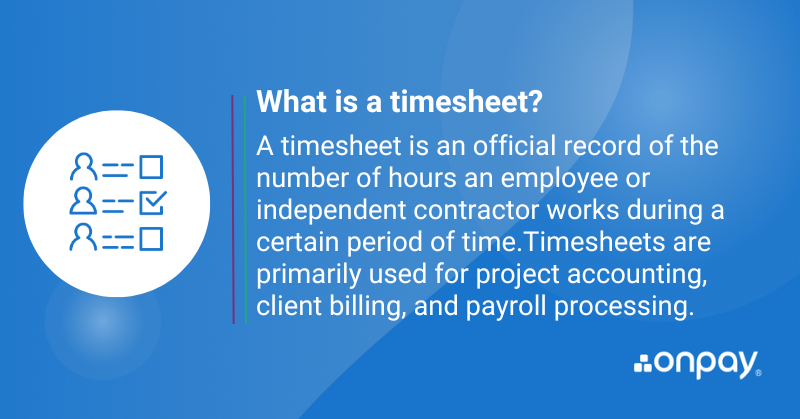Updated: November 11, 2024
Timesheet definition and meaning
A timesheet is an official record of the number of hours an employee or independent contractor works during a certain period of time. Timesheets are primarily used for project accounting, client billing, and payroll processing.
More about timesheets
The first time card system was invented in the 1880s. Employees would insert a time card into a mechanical time clock when they started and finished work, which would “punch” the time on their card. Hence, the terms “punching in” and “punching out” of work became popular. Punch cards were even used in some of the earliest desktop computers.
To record employee hours, workplaces initially used punch cards, then shifted to paper-based timesheets, which in turn have been replaced by digital timesheets. Not only are digital timesheets more accurate and efficient, but they also make it easier to bill clients, track employee productivity, and remain in compliance with federal and state labor laws.
Timesheets can be recorded on paper or electronically, either online or using digital spreadsheet software (or with tools like Microsoft Excel or Google Sheets). They are usually filled out by employees, though at some companies there will be direct managers or supervisors who will complete timesheets for employees.

Benefits of time tracking
With time tracking, employees’ hours are recorded at whatever time interval is needed for a particular project: daily, weekly, monthly, or semi-monthly, for example. The software provides employers with an overview of the work status for the project, which helps track employee performance and productivity as well as job profitability.
This can be especially helpful when multiple employees are working on various projects at different times. It helps managers assign specific duties, along with due dates and milestones, and keep track of various stages of each project. Timesheet software assists with workflow management, expense control, timely decision making, and efficiency analysis.
Uses of timesheets
Timesheets serve three main purposes:
- Payroll processing — The timesheet serves as an official record of how many hours employees worked during a certain pay period. This record is used to calculate their pay during the period.
- Project accounting — By recording the start and end times for project-related tasks, timesheets play an important role in performing cost accounting. This, in turn, helps companies determine the profitability of certain jobs and clients, as well as employee efficiency.
- Client billing — The data included on timesheets may be used when determining how much to bill clients for services performed. This is especially true if the client is being billed at an hourly rate like at most legal and accounting firms.
Benefits of using timesheets
Timesheets can be beneficial for employers and employees. Some benefits that employers may want to consider include:
- Using timesheets can help to monitor when employees are starting and stopping work or when they’re taking breaks. This could shed light on how efficiently schedules are being organized, and let managers see whether employees are working when they’re supposed to be.
- Because timesheets collect specific details related to how much time is being spent on tasks. This is especially useful for companies with clients who expect reporting on billable hours. Timesheets also allow for spotting issues with employee efficiency or scheduling challenges – which can then be corrected if needed.
- Having this data can go a long way toward simplifying payroll processing and project invoicing because the timesheet includes all time entry details for each employee during a pay period.
Employees may appreciate how timesheets can be a good idea too.
- Tracking the hours someone has worked should lead to hours being accounted for properly so both the employee and the employer know how much time is being spent on specific projects during certain time periods.
- It can help staffers feel confident about their paychecks being as accurate as possible because all the time they have worked is being kept on file. In most cases, employees should be able to see the details about how many hours they have put in, and if something seems off, they can compare it to their pay stubs.
- Timesheets serve as a legal document ensuring that employees receive the compensation and other benefits they’re legally entitled to.
The importance of timesheet compliance
The Fair Labor Standards Act (FLSA) establishes minimum wage, overtime pay (including time-and-a-half pay), and recordkeeping standards for most U.S. businesses. Timesheets are a critical component of FLSA compliance since they track how many hours non-exempt employees are working each week, including overtime hours (i.e., over 40 hours in a single week) for which they must be paid time-and-a-half.
In addition, some businesses that contract with the federal government must remain in compliance with the Defense Contract Audit Agency (DCAA). This includes approving completed timesheets, maintaining an audit trail of all timesheet changes, and preparing regular reports for the government agency about the number of hours worked by employees and contractors.
Timesheet attestation will help prove that a company’s timesheet practices are compliant with FLSA, DCAA or other regulations. Adding a timesheet attestation clause to the timesheet policy will reduce the potential risk of liability. The clause should detail what employees should attest to and how the attestation process will work, as well as how any problem uncovered will be investigated and resolved.
Using timesheet in a sentence
“Timesheets are critical to our company’s ability to process employee payroll, bill clients accurately, and assess the profitability of jobs and clients, as well as remain in compliance with the Fair Labor Standards Act.”
Terms related to: Timesheet
Articles and resources related to: Timesheet

